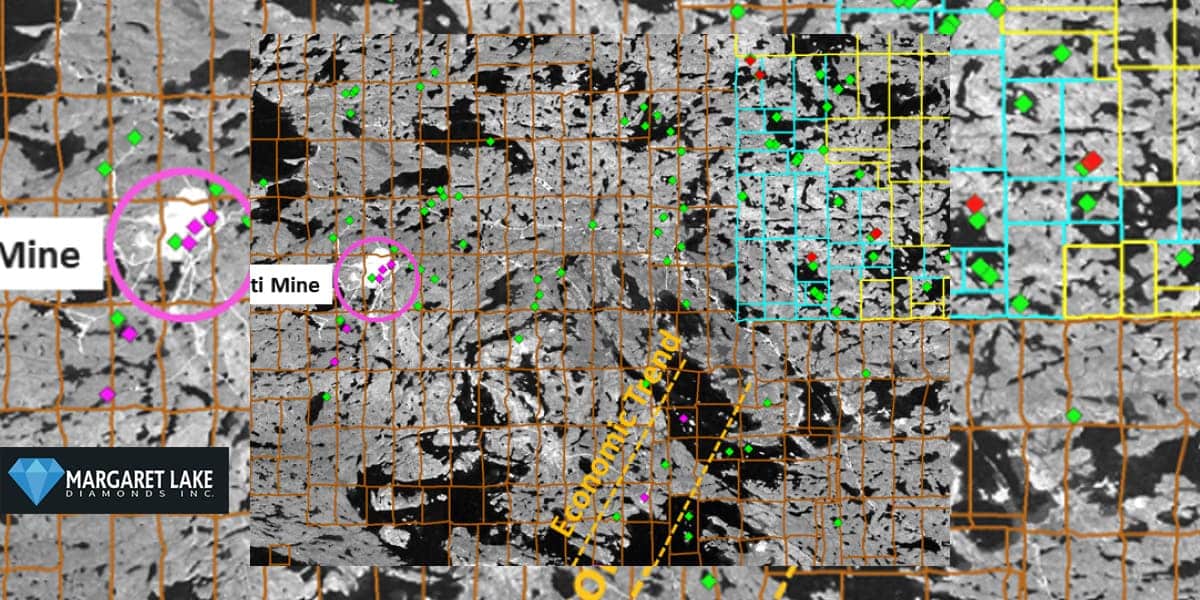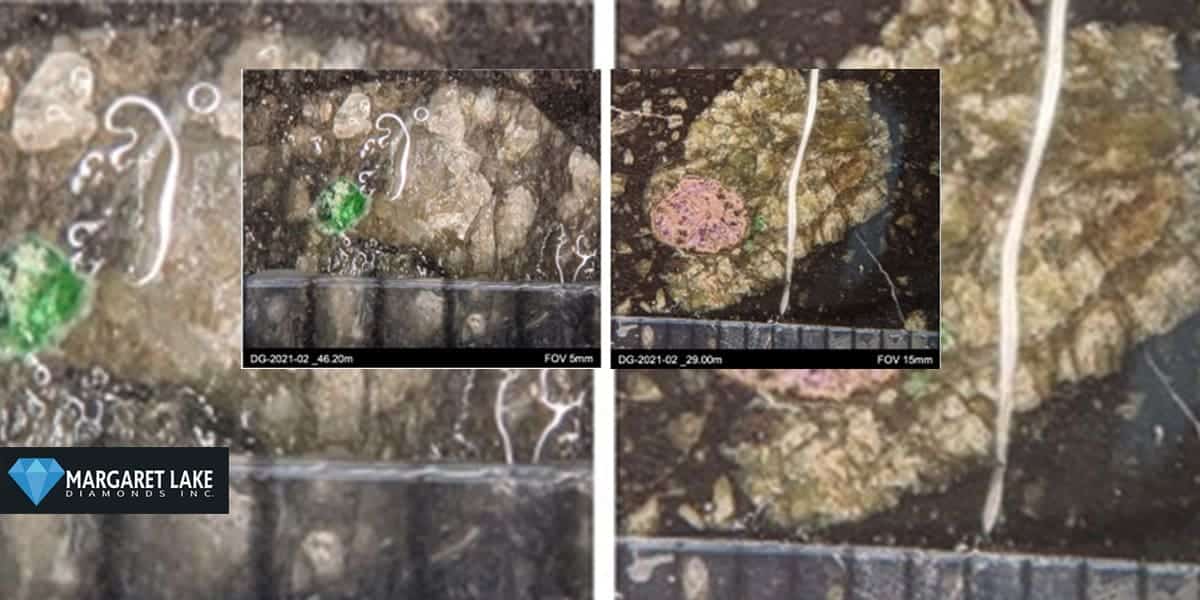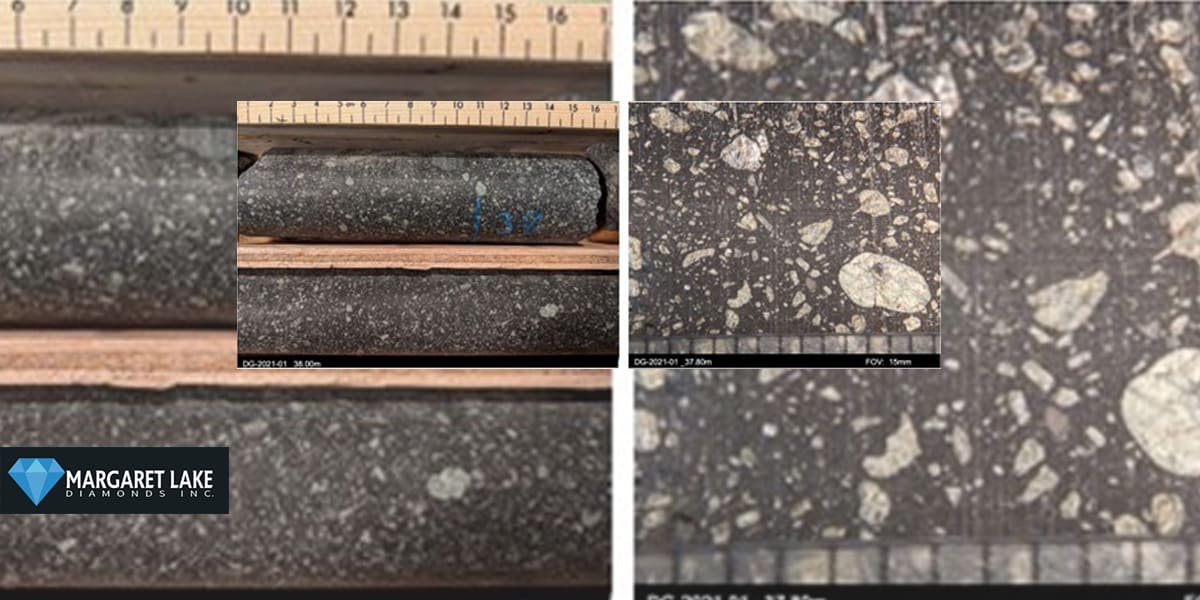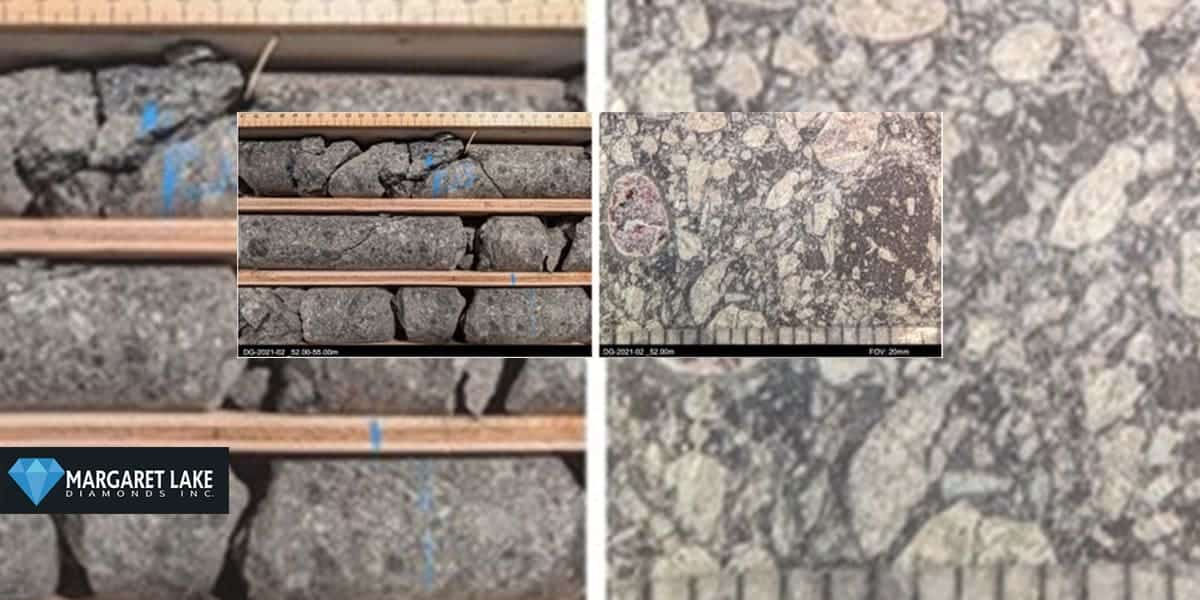
Margaret Lake Diamonds Inc. is engaged in the exploration, development, and production of mineral properties focusing mainly on diamond exploration. As part of its joint venture with Arctic Star Exploration, MLD holds an 18.5 per cent interest in the Diagras diamond project Northwest Territories property.
Summary
The Diagras Property consists of 58 contiguous claims staked by Arctic Star, with an area of 48,346 hectares. The property is in joint venture with Margaret Lake Diamonds whereby Arctic Star owns 81.5% interest and Margaret Lake 18.5% interest. The property is located in the north-eastern part of the prolific Lac de Gras kimberlite field, 22km NNE of the Diavik diamond mine and 36km east of the Ekati diamond mine in NWT Canada.
The company discovered the Sequoia Kimberlite Complex, in Spring 2021. From a small sample, two commercial diamonds were recovered and diamond chemistry, suggesting potential for large diamonds >52 cts.
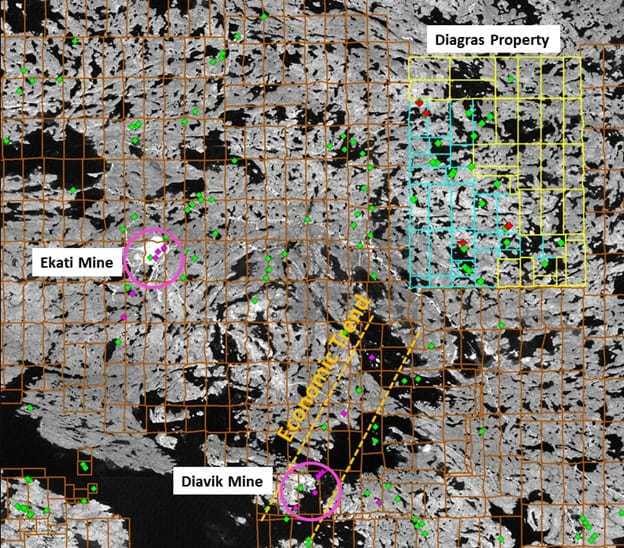
Kimberlite 1 is described as a black olivine poor resedimented volcanoclastic kimberlite and Kimberlite 2 as a grey clast supported olivine rich resedimented volcanoclastic kimberlite. Kimberlite 1 has a high percentage of mudstones imparting the dark colour. Kimberlite 2 has an abundant mantle derived fragments and indicator minerals whereas these are not common in Kimberlite 1. It was noted that kimberlite 2 contained fragments of kimberlite 1.
Table 1 summarizes the geology from the 2 Birch kimberlite holes, the first drilled vertical and the second drilled to the east at 82.2 degrees dip from the same location.
Table 1.
| Drill hole | From | To | Interval | Geology |
| DG-2021-01 | 0m | 28m | 28m | Overburden |
| 28m | 32.66m | 4.66m | Kimberlite 1 | |
| 32.66m | 35.4m | 2.74m | Kimberlitic 2 | |
| 35.4m | 50.36m | 14.96m | Kimberlitic 1 | |
| 50.36m | 54.45m | 4.09m | Kimberlitic 2 | |
| 54.45m | 62.78m | 8.33m | Kimberlitic 1 | |
| 62.78m | 71.71m | 8.93m | Kimberlitic 2 |
A total of 43.71m of Kimberlitic, 27.96m (64%) of Kimberlitic 1 & 15.76m (36%) of Kimberlitic 2.
Table 2.
| Drill hole | From | To | Interval | Geology |
| DG-2021-02 | 0m | 26.75m | 26.75m | Overburden |
| 26.75m | 34.96m | 8.21 m | Kimberlitic 1 | |
| 34.96m | 38.76m | 3.8m | Kimberlitic 2 | |
| 38.76m | 41.00m | 2.24m | Kimberlitic 1 | |
| 41.00m | 46.2m | 5.2m | Kimberlitic 2 | |
| 46.2m | 48.95m | 2.75m | Kimberlitic 1 | |
| 48.95m | 64.7m | 8.93m | Kimberlitic 2 |
Total 37.95m of kimberlite, 13.2m (35%) Kimberlite 1 & 24.26m (65%) Kimberlitic 2.
Total kimberlite 81.66m.
The kimberlite NQ size drill core was mechanically split and half of it was sent to CFM laboratories in Kelowna for caustic fusion. Table 3 lists the samples sent to this laboratory. The portions of the two kimberlite types from the two holes are 50/50.
Table 3 Sample weights sent for Caustic Fusion.
| Hole | Kimberlitic | Sample Weight (kgs) |
| DG2021-01 | Birch | 78.74 |
| DG2021-02 | Birch | 71.80 |
Total 150.54kg. 20 samples.
Samples were sent in 8kg charges (which represent approximately 4.3m of core separated by geology where possible). The lab began processing 12 days ago, which has a rate of 3 samples every two days.

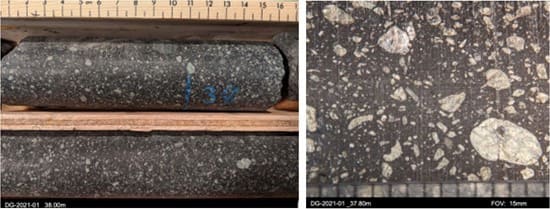
Kimberlitic 1: Conspicuous white olivine in a dark mud derived matrix. Matrix supported, poorly sorted. About 20% Olivine. with 5% broken fine to medium (1-4 mm) irregular, anhedral shaped macrocrysts and 15% occasionally broken, subhedral, elongate, very very fine to fine (0.25-1 mm ) phenocrysts. All olivine is completely altered to light green serpentine with minor carbonate. Country rock xenoliths comprise <10% of this core and are dominated by weak to moderately altered granite, ranging in size from 0.2-1 cm with rare up to 10 cm observed. Less common mudstone and diabase fragments up to 2 cm are also observed. Rare Indicators of 0.5-5 mm dark purple and red pyrope with thin kelphitic rims are observed. Magmaclasts are rare and have thin incomplete or complete dark brown rims around country rock fragments.

Kimberlitic 2: Dark grey colour comprised of closely packed olivine crystals and country rock xenoliths in black mud matrix, clast supported. Olivine abundance is around 40-50% with an irregular coarse population 30% broken fine to coarse (1-8 mm) irregular, anhedral shaped macrocrysts and occasionally broken, subhedral, elongate, (0.25-1 mm) phenocrysts. All olivine is completely altered to light green serpentine with minor carbonate. Country rock xenoliths comprise 10-20% of this core and are dominated by altered granite, ranging in size from 0.2-1 cm with rare up to 10 cm observed. Less common mudstone and diabase fragments up to 2 cm are also recorded. Matrix is black and composed of mud and minor lithic fragments with weak carbonate alteration. Indicators of 0.5-5 mm dark purple and red pyrope with thin kelphitic rims are common. <1mm bright green chrome diopsides are observed. Magmaclasts are common with thin incomplete or complete dark brown rims around country rock fragments. Autoliths of KIMB1 0.5-5 cm is observed. Mantle xenoliths of peridotite 0.5-1 cm are observed.
The company also received the final ground geophysical data from around the Birch discovery a figure 3, summarizes these results. The Birch kimberlite occurs to the SE of the Black Spruce Kimberlite discovered in the 1990’s by drilling a prominent magnetic low. The black ellipse in the figure outlines that magnetic anomaly and is our best guess for its location. In the figure the ground Ohmmapper survey that measures resistivity, the colours highlight the more conductive zones as the “hot” red/magenta colours. The Red ellipses are anomalies generated by a ground gravity survey (Gravity lows). The data suggests the Birch kimberlite is a 150m long ellipse as defined by the gravity and EM. The other red ellipses are secondary gravity anomalies.





